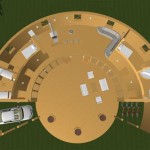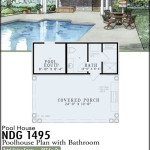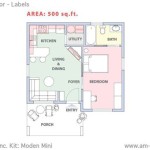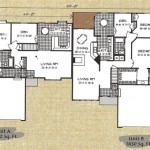US House Floor Plans: A Comprehensive Guide
Understanding US house floor plans is crucial for prospective homeowners, architects, and builders alike. A floor plan serves as a blueprint, providing a visual representation of a house's layout and dimensions. It details the arrangement of rooms, walls, doors, windows, and other structural elements. A well-designed floor plan optimizes space utilization, enhances functionality, and contributes significantly to a home's overall appeal and value.
Key Considerations When Evaluating US House Floor Plans
Several factors contribute to a successful floor plan. These considerations influence not only the aesthetics but also the practicality and livability of a home.
1.
Lifestyle Needs:
The floor plan should reflect the specific needs and lifestyle of the occupants. Families with children may prioritize separate play areas or larger bedrooms, while individuals working from home may require a dedicated office space. 2.Traffic Flow:
Effective traffic flow minimizes congestion and ensures easy movement between rooms. It considers the natural pathways inhabitants take within the house. 3.Natural Light:
A well-designed floor plan maximizes natural light, contributing to a brighter and more energy-efficient home. Strategic placement of windows and skylights can significantly influence this aspect. 4.Privacy:
The arrangement of rooms should offer adequate privacy for occupants. Bedrooms and bathrooms should be located away from high-traffic areas. 5.Space Utilization:
Effective space utilization ensures that every square foot serves a purpose, avoiding wasted space. Open-plan layouts can create a sense of spaciousness, while strategically placed storage solutions can maximize functionality. 6.Future Adaptability:
A forward-thinking floor plan considers potential future needs, such as expanding families or aging in place. Flexible spaces that can be repurposed easily are valuable. 7.Building Codes and Regulations:
Floor plans must adhere to local building codes and regulations, ensuring safety and structural integrity. These codes dictate minimum room sizes, hallway widths, and other essential dimensions.Types of US House Floor Plans
Various architectural styles and design preferences have led to the development of several distinct types of house floor plans. Each offers unique advantages and caters to different lifestyles.
1.
Open Floor Plans:
These plans prioritize spaciousness and flow by minimizing interior walls. They often combine the living room, dining area, and kitchen into a single, large space, promoting interaction and a sense of community. 2.Ranch House Plans:
Single-story homes that offer easy accessibility and minimal stairs. They are ideal for families with young children or individuals with mobility challenges. 3.Two-Story House Plans:
These plans maximize space utilization by stacking rooms vertically. They typically feature bedrooms on the upper level and living areas on the ground floor, offering greater privacy. 4.Split-Level House Plans:
These plans incorporate staggered floor levels, creating distinct zones within the house. They often feature a living area on one level, bedrooms on another, and a basement or recreational space on a lower level. 5.Multi-Generational House Plans:
Designed to accommodate multiple generations living under one roof, these plans often include separate living spaces or in-law suites with private entrances and kitchenettes.Reading and Interpreting US House Floor Plans
Understanding the symbols and conventions used in floor plans is essential for accurate interpretation.
1.
Walls:
Typically represented as thick black lines, indicating the exterior and interior walls of the house. 2.Doors:
Represented by a line with an arc indicating the direction of swing. 3.Windows:
Represented by parallel lines within the wall lines. 4.Dimensions:
Numerical values indicating the length and width of rooms and other structural elements. 5.Scale:
A ratio that indicates the relationship between the dimensions on the floor plan and the actual dimensions of the house. 6.Room Labels:
Text labels identifying the function of each room. 7.Symbols for Fixtures:
Standard symbols are used to represent plumbing fixtures, electrical outlets, and other features.Utilizing Online Resources for US House Floor Plans
Numerous online resources offer a vast collection of pre-designed house floor plans and customization tools. These platforms provide a convenient and cost-effective way to explore different layouts and find inspiration.
1.
Architectural Websites:
Many architectural websites offer free and paid access to a library of house plans. 2.Home Design Software:
Software programs allow users to create and modify floor plans digitally, offering flexibility and customization options. 3.Real Estate Listings:
Online real estate listings often include floor plans for listed properties, providing valuable insight into the layout and dimensions of existing homes.Importance of Consulting with Professionals
While online resources provide a starting point, consulting with qualified professionals is crucial for ensuring a successful outcome.
1.
Architects:
Architects can design custom floor plans tailored to specific needs and site conditions. 2.Builders:
Builders provide valuable input on the feasibility and cost implications of different floor plans. 3.Interior Designers:
Interior designers can assist with optimizing space utilization and selecting finishes that complement the floor plan.Adapting US House Floor Plans to Specific Lots
The topography and orientation of a building lot significantly influence the suitability of a house floor plan.
1.
Lot Size and Shape:
The dimensions and shape of the lot dictate the maximum footprint of the house and the potential layout options. 2.Slope:
Sloped lots may require modifications to the foundation and grading to accommodate the terrain. 3.Orientation:
The direction the house faces impacts natural light and energy efficiency. A south-facing orientation can maximize solar gain.Evolution of US House Floor Plans
House floor plans have evolved significantly over time, reflecting changing lifestyles and technological advancements.
1.
Historical Influences:
Traditional architectural styles have influenced the development of various floor plan layouts. 2.Modern Trends:
Contemporary floor plans prioritize open spaces, flexible layouts, and sustainable design principles. 3.Technological Advancements:
Advances in building materials and construction techniques have enabled the creation of more complex and innovative floor plans.
2422 R Spokane House Plans Perfect For Tge Five Of Us Bungalow Floor Building Designs Style

New American Best House Plans Floor And Photos

2 820 Sq Ft House Plan With 4 Bedrooms 1509

Barn Plan 2 979 Square Feet 4 Bedrooms 3 5 Bathrooms 009 00359

New American Best House Plans Floor And Photos

Luxury Style House Plans 4016 Square Foot Home 1 Story 4 Bedroom And 3 Bath 2 Garage Stalls By Monster Modern Floor

Classic American Home Plan 62100v Architectural Designs House Plans

Modern Farmhouse Plan 2 181 Square Feet 3 4 Bedrooms Bathrooms 009 00370

Home Plan Brindisi Sater Design Collection

House Plan 61323 Traditional Style With 3602 Sq Ft 4 Bed 3 Ba








